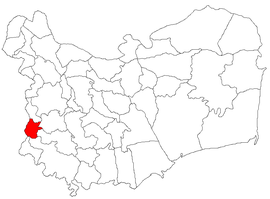
Moldova Nouă is a town in southwestern Romania in Caraș-Severin County, in an area known as Clisura Dunării. The town administers three villages: Măcești, Moldova Veche, and Moldovița.

Northern Dobruja is the part of Dobruja within the borders of Romania. It lies between the lower Danube River and the Black Sea, bordered in the south by Southern Dobruja, which is a part of Bulgaria.

Dobruja or Dobrudja is a geographical and historical region in the Southeast Europe that has been divided since the 19th century between the territories of Bulgaria and Romania. It is situated between the lower Danube River and the Black Sea, and includes the Danube Delta, Romanian coast, and the northernmost part of the Bulgarian coast. The territory of Dobruja is made up of Northern Dobruja, which is a part of Romania, and Southern Dobruja, which is a part of Bulgaria.
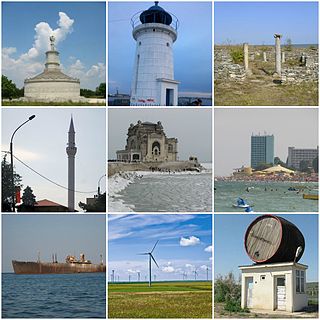
Constanța is a county (județ) of Romania on the border with Bulgaria, in the Dobruja region. Its capital city is also named Constanța.
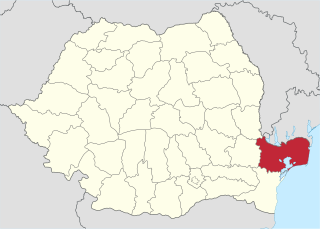
Tulcea County is a county (județ) of Romania, in the historical region Dobruja, with the capital city at Tulcea. It includes in its northeast corner the large and thinly-populated estuary of the Danube.

Tulcea is a city in Northern Dobruja, Romania. It is the administrative center of Tulcea County, and had a population of 65,624 as of 2021. One village, Tudor Vladimirescu, is administered by the city.

Isaccea is a small town in Tulcea County, in Northern Dobruja, Romania, on the right bank of the Danube, 35 km north-west of Tulcea. According to the 2021 census, it has a population of 4,408.

Măcin is a town in Tulcea County, in the Northern Dobruja region of Romania.

Nikopol is a town in northern Bulgaria, the administrative center of Nikopol Municipality, part of Pleven Province, on the right bank of the Danube river, 4 kilometres downstream from the Danube’s confluence with the Osam river. It spreads at the foot of steep chalk cliffs along the Danube and up a narrow valley.

Troesmis was an ancient Dacian town and later ancient Roman city and legionary fortress, a major site situated on the Danube and forming a key part of the Limes Moesiae frontier system. It is situated in what is now Romania near Igliţa-Turcoaia. Around this fortress the Geto-Dacian town later developed.
Beroe or Beroë may refer to :

Pietroasele is a commune in Buzău County, Muntenia, Romania, known for its vineyards. The name means "the rockies". The commune is composed of six villages: Câlțești, Clondiru de Sus, Dara, Pietroasa Mică, Pietroasele and Șarânga. It became famous with the discovery in 1837 of the Pietroasa Treasure composed of several pieces of gold and precious stones. The Romanian historian Alexandru Odobescu wrote a book on the archaeological discovery.

Dinogetia was an ancient Geto-Dacian settlement and later Roman fortress located on the right (southern) bank of the Danube near the place where it joins the Siret. The Dinogetia site is situated in Northern Dobruja 8 kilometres east of Galați, Romania and 2 kilometers north of Garvăn, a village in Jijila commune.
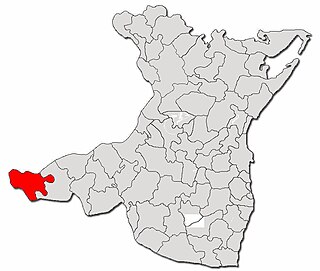
Ostrov is a commune in Constanța County, Northern Dobruja, Romania.

Gârliciu is a commune in Constanța County, Northern Dobruja, Romania, containing the village with the same name.
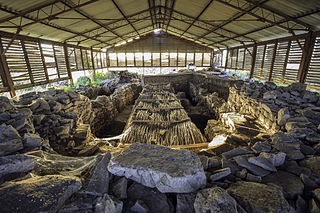
Halmyris was a Roman and Byzantine fort, settlement and naval port, located 2.5 km west of the village of Murighiol at the mouth of the Danube Delta in Romania.
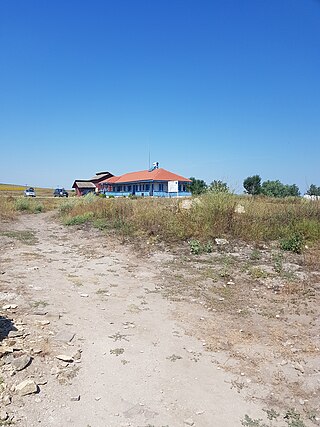
Murighiol is a commune in Tulcea County, Northern Dobruja, Romania. It is composed of seven villаges:

The Moesian Limes is the modern term given to a linked series of Roman forts between the Black Sea shore and Pannonia along the Danube. It was the eastern section of the so-called Danubian Limes and protected the Roman provinces of Upper and Lower Moesia south of the river. The eastern section is often called the limes Scythiae minoris as it was located in the late Roman province of Scythia Minor.
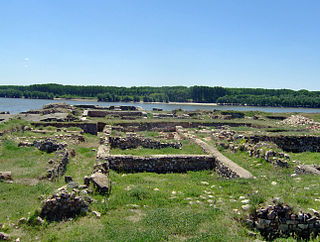
Capidava was an important Geto-Dacian center on the right bank of the Danube. After the Roman conquest, it became a civil and military centre, as part of the province of Moesia Inferior, modern Dobruja.
The Danubian Limes, or Danube Limes, refers to the Roman military frontier or limes which lies along the River Danube in the present-day German state of Bavaria, in Austria, Slovakia, Hungary, Croatia, Serbia, Bulgaria and Romania.
